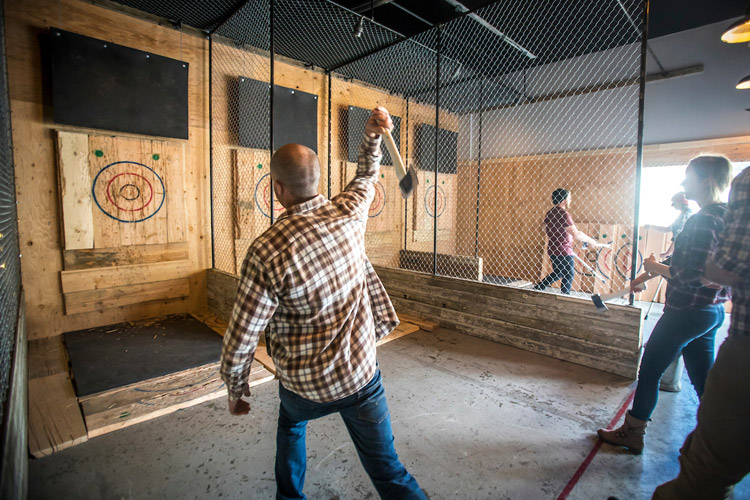The Enjoyable of Axe Throwing: How This Sporting Activity Integrates Ability and Adrenaline for a Fun Time
Axe throwing has emerged as a mesmerizing sport that masterfully intertwines the requirement for precise skill with the rush of adrenaline, offering participants a appealing and unique experience. The act of hurling an axe in the direction of a target requires concentration and technique, all at once fostering an atmosphere of camaraderie and friendly rivalry.
The Beginnings of Axe Throwing
Axe throwing, a recreational activity that has actually gotten significant appeal in current years, traces its roots back to ancient times. The earliest documents of axe use in affordable contexts are located amongst the Celts and Vikings, who threw axes for sport as well as in fight training.
Medieval European warriors, especially throughout the Middle Ages, practiced axe throwing as part of their martial training. The Francisca, a sort of throwing axe made use of by the Franks, ended up being famous for its lethal accuracy. This standard tool was developed to be thrown at adversary shields and shield, showcasing its dual energy in both sport and battle.
In more recent history, axe throwing saw a rebirth in the logging camps of North America in the 19th and 20th centuries. Lumberjacks would certainly participate in pleasant competitors, evaluating their precision and toughness by aiming at wood targets. This evolution from a survival ability to a recreational activity has actually led the way for its contemporary rebirth, with specialized venues and organizations now commemorating the sporting activity around the world.
Devices You Need
Recognizing the rich background of axe tossing enhances the recognition of the sporting activity's modern-day model. For recreational and competitive axe tossing, the most generally used type is the hatchet, generally evaluating in between 1.25 to 2 extra pounds with a handle length of around 16 inches.
Just as essential is the target. Regulation targets are created from timber, with softwood selections like pine or cottonwood being liked for their capacity to hold the axe and take in. The target is typically split right into five concentric circles, each with a particular point value, to promote scoring.
Safety and security equipment, though commonly overlooked, is critical. Protective handwear covers can improve grasp and prevent sores, while closed-toed footwear are a must to secure feet from gone down axes (axe throwing denver co). A well-lit, spacious throwing location, full with security obstacles, makes sure a controlled atmosphere where participants can focus on sharpening their skills.
Fundamental Techniques Clarified
Understanding the basic methods of axe throwing is necessary for both security and proficiency. The very first strategy to understand is the hold. Hold the axe with a firm, yet loosened up hold, similar to holding a golf club. The dominant hand must be placed directly listed below the axe head, while the non-dominant hand sustains the end of the manage.
Following, concentrate on the stance. Stand with your feet shoulder-width apart, ensuring your body is stabilized. Your dominant foot must be a little ahead, lining up with your target. This positioning aids in keeping security and guiding power precisely towards the target.

Safety And Security First
Making certain security in axe throwing is vital to producing a satisfying and injury-free experience. Precaution start with the place design. A well-designed axe throwing facility functions clear separations between tossing lanes, durable backgrounds to catch roaming axes, and non-slip flooring to stop crashes. Additionally, adequate lighting is critical to help individuals keep aesthetic precision and spatial recognition.
Benefits of Axe Throwing
Axe tossing offers a myriad of benefits that expand past easy entertainment. Literally, it gives a full-body workout, engaging muscles in the arms, shoulders, back, and core. The recurring movement of tossing the axe likewise enhances hand-eye sychronisation and fine motor skills. For those aiming to enhance their overall health and fitness, axe throwing can work as a vibrant and interesting kind of exercise.
Emotionally, axe tossing calls for technique, precision, and emphasis, making it an excellent means to sharpen cognitive skills. The concentration required to strike the target can offer as a form of mindfulness, enabling individuals to clear their minds and decrease stress and anxiety. This mental engagement can be particularly advantageous in aiding individuals create much better analytic skills and psychological resilience.
Socially, axe throwing is often enjoyed in group setups, promoting team-building and camaraderie. Whether as part of a business event or a casual getaway with friends, the sporting activity motivates interaction and collaboration. In addition, the public experience of learning and boosting with each other can reinforce connections and create Extra resources lasting memories.
Final Thought

The earliest documents of axe use in affordable contexts are found amongst the Celts and Vikings, who tossed axes for sporting activity as well as in fight training. Launch the axe when your hands are about at eye level, enabling the axe's natural rotation to lead it towards the target.
A properly designed axe throwing facility attributes clear demarcations between throwing lanes, tough backdrops to catch roaming axes, and non-slip flooring to protect against crashes. Individuals should be advised on the proper method to toss the axe and manage, emphasizing regulated, intentional motions over powerful throws.
In recap, axe throwing stands out as a sporting activity that masterfully integrates adrenaline, skill, and accuracy.